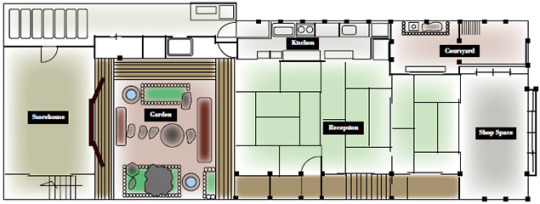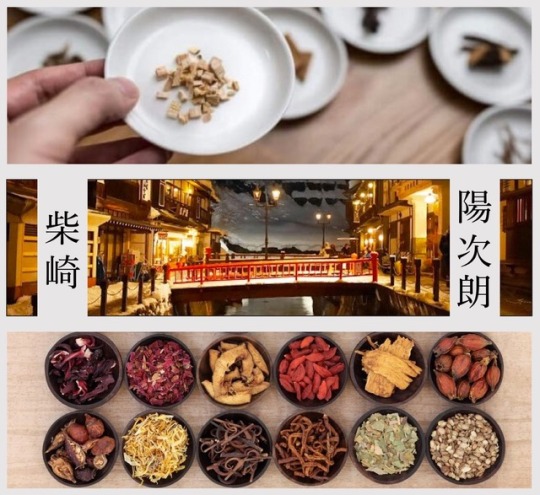#JWW: Medicine
Note
is their set up for the hospital wing the same as Hogwarts?
Nope! You can read more about Nagumo (Mahoutokoro) and its basic layout here.
Short answer: The Japanese “castle” includes in its definition the main keep, watchtowers, and castle town. The main keep (the big castle building you’ll see if you search for images of a ‘Japanese castle’) is used as an administrative building that has open areas to host events, meetings, and ceremonies, as well as some offices for administrative staff.
However, in my Nagumo/Mahoutokoro, this main keep is not used for the school’s day-to-day activities; the space simply wasn’t made to accommodate such things. It was mainly a giant defense tower with some living space at the top for the lord of the castle.
The infirmary would be located in a dedicated building (likely an old pharmacy/apothecary) in the castle town surrounding the main keep. The academic buildings are also scattered throughout the castle town.
The setup I would choose is that of a Japanese machiya (a traditional townhouse), pictured below.

Details under the read more:
The front would look like a store with medicine cabinets (see below) lining the walls, similar to the ones in Spirited Away if you’ve ever seen that movie. Beyond the store space would be an area for examining patients (the green area labeled “reception” would likely be converted for this function) and keeping them overnight, if they need observation. Since much of the space in traditional Japanese houses could be partitioned using the sliding doors, you could narrow or expand the space as necessary.
The wixen doctor (medi-wix?) would live on-premises, in the upstairs living space.
And, if for some reason they needed more space to house students overnight, there are nearby houses that don’t have anyone living in them that can be used (Nagumo owns the entire island, so this wouldn’t be an issue; the businesses in the castle town are simply renting the space).

26 notes
·
View notes
Photo


Wixen Locations: Kasuga School of Medicine [春日医科大学]
Type: Hospital, School
Location: Myōkō, Niigata Prefecture
Name Meaning: 春 means ‘spring’ and 日 means ‘day’
Informational Brochure
Location
Kasuga School of Medicine was established next to the Joshin'etsu Kogen National Park due to the multitude of magical herbs and potions ingredients found in the surrounding mountains and foothills. A muggle resort is located nearby, but rest assured, Kasuga Hospital is well concealed by muggle-repelling spells based on proven western methods and spellwork.
About
Kasuga School of Medicine is a relatively new establishment based on the much older Kasuga Clinic that was previously located in Niigata City and operated in the middle of muggle society. Founded forty years ago, Kasuga Hospital has since expanded its scope and opened a medical school for graduates of primary magical institutes such as Nagumo Academy.
Rather than rely solely on traditional methods, we at Kasuga employ both the old and the new to provide our patients with optimal care. The research performed here strives to improve and challenge the limits of magical medicine every day.
Staff:
Koyama Irie: A wixen doctor working in the internal medicine department. Of her colleagues, she is the most knowledgable about conditions with no magical origin. She is also the daughter of well-known wixen surgeon, Uguchi Tomiko.
Tazaki Shōya: A wixen surgeon specialized in neurosurgery and well-versed in magical-neurological problems. His surname used to be Hirata. During his school days, his origins as the son of a member of the Sisterhood of the Sakura was exposed.
Komakichi: A hainu, a winged dog yōkai, owned by the director of the hospital. He is nicknamed Koma and loves to visit the patients. The children especially love to watch Koma fly around outside.
Notes:
The hospital has 180 beds and room for 20 more in the case of an emergency.
It started implementing modern magical medicine and later, in a controversial move, decided to use muggle techniques as well, after Shibasaki Yōjirō’s New Handbook of the Traditional and Western Healing Arts (1988) was published.
It also uses a lot of western magic that is not as popular elsewhere, for architectural and security purposes.
Needless to day, it is not as popular among the older generation.
Image Sources: Left, Right
31 notes
·
View notes
Photo


Magical Diseases: Fox Possession (狐憑き, kitsunetsuki)
The origins of the magical disease known as kitsunetsuki has been subject to much debate over the centuries since people first began noticing the telltale, terrifying symptoms of fox possession: foxlike behavior such as yelping, running on all fours, and changes in diet, to an alteration of physical traits like elongated faces, sharp teeth, claws, and in the latest stage of the disease, appendages of a fox.
Current research proposes that the disease began in mundane foxes, driving them into feral madness and eventually death. Fox spirits of the kiko rank, known to live amongst mundane foxes, likely contracted it and passed it onto fox spirit hanyou whose fox parent was of a lower rank, thus giving their hanyou offspring less potent youkai magic and lower immunity. The highly mutative nature of youkai magic, when combined with the hanyou’s innate human magic, twisted the disease into a form able to infect wixes and non-magical humans alike.
At present, two strains of the kitsunetsuki disease exist: a passive and an active strain. The passive variant, jugitsunetsuki, produces the same symptoms as the active variant, kougitsunetsuki, and is often mistaken for it. It is the active kougitsunetsuki that is the most troublesome, for it can be spread to those who harm or offend an infected fox spirit through the highly mutative and negative youkai magic that interacts with the fox’s resentment.
It is notable that the disease is not inherently fatal in fox spirits and humans, but the active strain is much more difficult to cure than the passive one. In cases where the kitsunetsuki cannot be expelled, wixes must undergo rigorous treatment to manage the symptoms and return some amount of normalcy to their lives. The rest of this section deals with the methods of curing and treating kitsunetsuki in use today, as well as arguments for and against the most common treatments of the past and present.
– Shibasaki Tsune, Magical Psychology: Current Disputes (現在呪術心理学の論争)
Notes:
It used to be thought that all cases of fox possession were actively placed on the people who suffered from it. In fact, it was once considered a curse that causes a disease rather than a disease itself and the few western wixes who came to the country in the 1600s classified it as an illness of the mind. The particulars of fox possession would not be detailed in native magical medical texts until more research was performed in the late 1800s.
Read more about the active variant here, four paragraphs down, @themonsterblogofmonsters.
Details:
The passive variant is 受狐憑き (jugitsunetsuki) and the active variant is 攻狐憑き (kougitsunetsuki).
(source, source)
41 notes
·
View notes
Photo

Mahoutokoro Alumni: Shibasaki Yōjirō [柴崎 陽次朗]
Gender: Male
Birthday: February 5, 1899
Death: January 4, 1936
Residence: Tōkyō, Tōkyō Prefecture
Lineage: Half-Blood
Wand: Alder wood, 32 cm, crane feather
Name Meaning: 柴 means ‘brushwood’; 崎 means ‘cape, small peninsula’; 陽 means ‘sunshine/daytime’ or the principle of yang; 次朗 ‘jirō’ indicates he is the second son in the family
“To have scruples about one methodology or another is the defining feature of a supercilious fool. Whatever the medicine or technique may be, as long as it saves a patient’s life, who cares if it is magical or not, from the West or from tradition?”
New Handbook of the Traditional and Western Healing Arts (1988)
by Shibasaki Yōjirō | ed. Shibasaki Tsune
Preface
Shibasaki Tsune
Shibasaki Yōjirō is credited as the sole author of the ten volumes that comprise the most comprehensive multidisciplinary text of medicine and surgery in the modern era, but as his sister and editor, it would be terribly remiss of me to fail to mention the ones whose contributions allowed my brother to compose his life’s work. While I understand the publishers’ refusal to list these men and women as co-authors on the grounds that they are non-magical, it would weigh heavily on my conscience to ignore the value of their research and role in allowing this work to thrive.
When my brother left home and our parents’ practice in the summer of 1922, he initially worked under a family friend who was the head of magical surgery at the Imperial University. In the aftermath of the Great Kantō Earthquake in 1923, however, he vanished from the magical world. He was believed to be dead until a muggleborn mentioned him to my younger sister in Kyōto nearly five years later. He and a young muggle man, Haruta Sōha, had opened up an entirely non-magical practice in Tōkyō and were spearheading the revival of traditional medicine alongside the names of many muggle doctors I had never heard of.
(3/12/18: Moved & revamped from themahouproject.)
Notes:
Although he contributed greatly to the advancement of traditional Chinese medicine, his work in the magical healing arts was unknown until his older sister, Tsune, compiled his writings into the books titled above.
Yōjirō struggled with depression for most his life. Though emotionally sensitive and easily injured by the words of others, he never went back on the standards he set for himself. He could be a judgmental, highly opinionated guy around his closest friends (which were all, save for one, muggles) and didn’t have the best bedside manners, but his merits as a doctor were nearly unmatched.
In the last years of his life, Yōjirō was plagued by severe bouts of depression and a sense of foreboding for the future. Ultimately, his friend Haruta came home to the house they shared to find that he had hung himself.
Haruta Sōha was also the one he entrusted all of his non-magical research to. His only friend in the magical world, a girl named Saki from his Mahoutokoro days, received his other writings. Out of respect for his request that she not give them to his family, she held onto them for decades.
He could read and write Classical Japanese and read Classical Chinese, as well as a bit of English and German. He couldn’t speak any of these, though.
Mahoutokoro still provided boarding for all students regardless of age when he attended. The day program did not exist, so he lived away from home most of the year starting at age seven.
He graduated from Mahoutokoro’s (now defunct) general education program at sixteen and began apprenticing at his parents’ clinic in the same year.
Details:
Pictured: (top & bottom) Traditional Chinese medicine, called 漢方 ‘kanpō’ in Japanese. Although they developed their own techniques over the centuries, kanpo at its base is Chinese medicine. (center) Ginzan Onsen.
Name: They bear no relation to the Shiba clan despite their name. The Shibasakis, who were physicians for the imperial court back in the day, are more closely related to the Fujiwara. They were a lot less picky when selecting heirs and marriage arrangements, preferring to have those with talent in the family rather than pay attention to blood purity.
(source, source, source)
#Japanese Wizarding World#Mahoutokoro: Students#Mahoutokoro: Alumni#JWW: Medicine#tw: sucide mention
13 notes
·
View notes